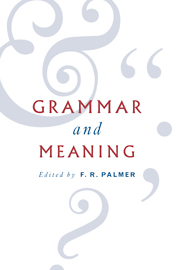Book contents
- Frontmatter
- Contents
- List of contributors
- Foreword
- 1 Polysemous relations
- 2 Fields, networks and vectors
- 3 Syntax, semantics, pragmatics
- 4 Natural-language interpretation as labelled natural deduction
- 5 Three levels of meaning
- 6 Does spoken language have sentences?
- 7 Grammaticalisation and social structure: non-standard conjunction-formation in East Anglian English
- 8 German Perfekt and Präteritum: speculations on meaning and interpretation
- 9 The possessed
- 10 Complement clauses and complementation strategies
- 11 Grammar and meaning
- John Lyons: publications
- Index
7 - Grammaticalisation and social structure: non-standard conjunction-formation in East Anglian English
Published online by Cambridge University Press: 30 January 2010
- Frontmatter
- Contents
- List of contributors
- Foreword
- 1 Polysemous relations
- 2 Fields, networks and vectors
- 3 Syntax, semantics, pragmatics
- 4 Natural-language interpretation as labelled natural deduction
- 5 Three levels of meaning
- 6 Does spoken language have sentences?
- 7 Grammaticalisation and social structure: non-standard conjunction-formation in East Anglian English
- 8 German Perfekt and Präteritum: speculations on meaning and interpretation
- 9 The possessed
- 10 Complement clauses and complementation strategies
- 11 Grammar and meaning
- John Lyons: publications
- Index
Summary
In this chapter I focus on a particular form of grammaticalisation process, the development of non-standard conjunctions in the rural traditional dialects (see Trudgill, 1990) of East Anglia. The factual grammatical information provided here is derived from my own personal knowledge of the dialects in question. The examples I supply for illustrative purposes are taken from dialect texts (presented here in normalised orthography) written by East Anglian writers who have made self-conscious attempts to write in the local dialect. The advantages of using this sort of material are obvious. There are now relatively few speakers of the traditional dialects left, and obtaining texts from native speakers that are of sufficient length to permit the study of grammatical features would be an extremely time-consuming process. There are also, of course, very obvious dangers with using this type of material as data. Dialect writing may be unreliable as a representation of actual dialect speech, employing inaccurate stereotypes and hyperdialectisms (Trudgill, 1986). In this particular case, however, I have selected only texts which I am confident are accurate representations of the dialect and have been written by genuine native speakers of the dialects in question. My confidence comes from a lifetime of living in East Anglia, from having had many older relatives and acquaintances who spoke the traditional dialect and from twenty-five years of academic study of these dialects. The examples, that is, should not be regarded as data as such, but simply as illustrations which support and confirm my own understanding of how these dialects work.
- Type
- Chapter
- Information
- Grammar and MeaningEssays in Honour of Sir John Lyons, pp. 136 - 147Publisher: Cambridge University PressPrint publication year: 1995
- 7
- Cited by



